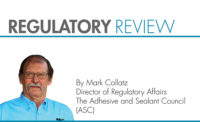Regulatory Review
Transparency through an Agency Website? Maybe Not.
The Office of Environmental Health Hazard Assessment’s (OEEHA) new website could create more confusion for the public at the expense of those doing business in California.

California regulators are at it again. In the name of providing transparency for consumers, the Office of Environmental Health Hazard Assessment (OEEHA) may be on the brink of creating more confusion for the public―at the expense of those doing business in the state. The mischief maker in this case is OEEHA’s recently finalized regulation under Prop 65 that will authorize the development and maintenance of a website to provide information regarding exposures to listed Prop 65 chemicals in consumer products sold in California. The website will reportedly explain which Prop 65-listed chemicals are included in certain types of products and methods of common exposure.
So how will the OEEHA get that information? Any way it can. In its Final Statement of Reasons (FSOR) published with the final rule, the agency concludes that most of the information published on the website will be obtained from “authoritative agencies.” But then it goes on to say that “manufacturers and other interested parties may submit information directly to OEEHA to be considered for publication.” It also notes that the website will include an agency disclaimer regarding the accuracy of information provided by third parties. That’s not much comfort for a company whose product ends up wrongfully mischaracterized on a state of California-maintained website that will most likely be considered gospel by consumers.
The idea that any third party can submit content for a website about a manufacturer’s product without the manufacturer having the opportunity to review or correct that information makes me a bit uneasy—and it should for you, too. During the proposal comment period, the ASC and others raised concerns about the possibility of product misinformation showing up on an official government website. The OEEHA’s response was that scientific and legal experts will be reviewing all material before it is allowed to be made public.
While that sounds like the right answer, think back just two short years when California’s Department of Toxic Substances Control published on its website a Priority Product Profile (PPP) for Spray Polyurethane Foam (SPF) systems as part of its new Safer Consumer Product Rule. That document named a number of polyurethane applications that had nothing to do with spray foam products. In addition, it lumped multiple chemistries and unrelated application systems together and—possibly worst of all—the report referenced chemicals that are not and never have been components of SPF systems. It took the ASC and spray foam manufacturers almost six months to get the agency to acknowledge its mistake and replace the PPP with an accurate document. Still, it wouldn’t be a complete shock to me if the original erroneous document isn’t out there on somebody’s website waiting to be misused. It’s a fact of life in the Information Age that nothing ever disappears from the Internet.
Another unintended consequence of this new website could be the return of the bounty hunter mentality that will use Prop 65 to legally extort money through frivolous lawsuits, a phenomenon that plagued the consumer product retail community in the early years of this law. The OEEHA has acknowledged that the website will discuss products in “generalities” of product categories and will not single out specific brands. Manufacturers of a certain type of product may formulate it to meet a unique function and, for that reason, may include a chemical that triggers the need for the Prop 65 label. Others basically making the same product for a more general purpose tend not to add the extra ingredient, and thus don’t include a warning label. A not-so-discriminating bounty hunter finds two generally similar products on retailers’ shelves, one with a Prop 65 label and one without. We have the makings of a lawsuit. Will the manufacturer without the label be able to defend itself? Of course, but it will cost money, take time and most likely entail some unfortunate publicity along the way.
Consumers deserve to be protected from unsafe products. Thirty years ago, the California public decided that a warning label should be attached to any product containing a listed Prop 65 chemical unless exposure is low enough to pose no significant risk of cancer or is significantly below levels observed to cause birth defects or other reproductive harm. For chemicals that are listed as causing cancer, the “no significant risk level” is defined as the level of exposure that would result in not more than one excess case of cancer in 100,000 individuals exposed to the chemical over a 70-year lifetime. In other words, a person exposed to the chemical at the “no significant risk level” for 70 years would not have more than a “one in 100,000” chance of developing cancer as a result of that exposure.
I think reasonable people would agree that is an extremely small threshold. The information that will eventually end up on this website is unlikely to provide any real contextual value for how these listed products impact the health of California consumers. On the other hand, it may prove a bonanza to an unscrupulous few looking to make a fast buck.
While the new website officially went live in early April, OEEHA staff has made it clear that it will take some time for them to begin to actually populate it with information, at least from the retail community. The ASC will continue to monitor how adhesive and sealant products are characterized on the site in order to ensure that the most accurate and representative information is shared with the public. We ask that our members and others in the industry help us in that effort.
Any views or opinions expressed in this column are those of the author and do not represent those of ASI, its staff, Editorial Advisory Board or BNP Media.
Looking for a reprint of this article?
From high-res PDFs to custom plaques, order your copy today!





